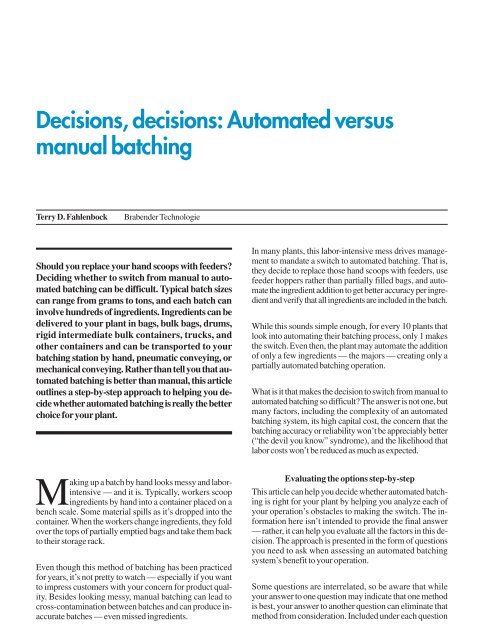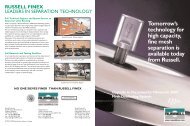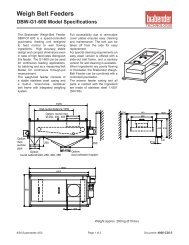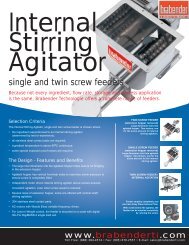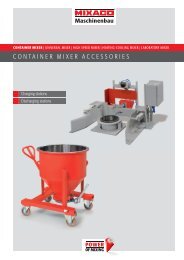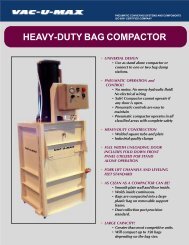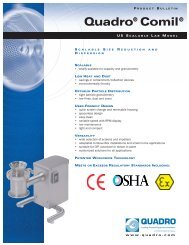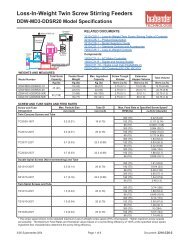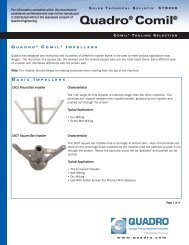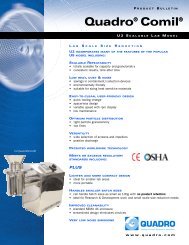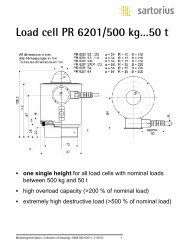Is Automatic Ingredi.. - Sawyer/Hanson Innovations
Is Automatic Ingredi.. - Sawyer/Hanson Innovations
Is Automatic Ingredi.. - Sawyer/Hanson Innovations
Create successful ePaper yourself
Turn your PDF publications into a flip-book with our unique Google optimized e-Paper software.
Decisions, decisions: Automated versusmanual batchingTerry D. FahlenbockBrabender TechnologieShould you replace your hand scoops with feeders?Deciding whether to switch from manual to automatedbatching can be difficult. Typical batch sizescan range from grams to tons, and each batch caninvolve hundreds of ingredients. <strong>Ingredi</strong>ents can bedelivered to your plant in bags, bulk bags, drums,rigid intermediate bulk containers, trucks, andother containers and can be transported to yourbatching station by hand, pneumatic conveying, ormechanical conveying. Rather than tell you that automatedbatching is better than manual, this articleoutlines a step-by-step approach to helping you decidewhether automated batching is really the betterchoice for your plant.In many plants, this labor-intensive mess drives managementto mandate a switch to automated batching. That is,they decide to replace those hand scoops with feeders, usefeeder hoppers rather than partially filled bags, and automatethe ingredient addition to get better accuracy per ingredientand verify that all ingredients are included in the batch.While this sounds simple enough, for every 10 plants thatlook into automating their batching process, only 1 makesthe switch. Even then, the plant may automate the additionof only a few ingredients — the majors — creating only apartially automated batching operation.What is it that makes the decision to switch from manual toautomated batching so difficult? The answer is not one, butmany factors, including the complexity of an automatedbatching system, its high capital cost, the concern that thebatching accuracy or reliability won’t be appreciably better(“the devil you know” syndrome), and the likelihood thatlabor costs won’t be reduced as much as expected.Making up a batch by hand looks messy and laborintensive— and it is. Typically, workers scoopingredients by hand into a container placed on abench scale. Some material spills as it’s dropped into thecontainer. When the workers change ingredients, they foldover the tops of partially emptied bags and take them backto their storage rack.Even though this method of batching has been practicedfor years, it’s not pretty to watch — especially if you wantto impress customers with your concern for product quality.Besides looking messy, manual batching can lead tocross-contamination between batches and can produce inaccuratebatches — even missed ingredients.Evaluating the options step-by-stepThis article can help you decide whether automated batchingis right for your plant by helping you analyze each ofyour operation’s obstacles to making the switch. The informationhere isn’t intended to provide the final answer— rather, it can help you evaluate all the factors in this decision.The approach is presented in the form of questionsyou need to ask when assessing an automated batchingsystem’s benefit to your operation.Some questions are interrelated, so be aware that whileyour answer to one question may indicate that one methodis best, your answer to another question can eliminate thatmethod from consideration. Included under each question
is an explanation of what you need to consider in answeringthe question. Some explanations also include tips formaking a decision.3Where will my ingredients be stored?To answer this question:1What are my ingredients and how are theyreceived at my plant?To answer this question:• Identify your ingredients.• Consider that you’ll probably add a few more ingredientsin the future, because your batch recipes and the ingredientsare likely to change.• Identify any toxic ingredients.• Identify any ingredients whose dust can create an explosiveair-dust mixture.• Explore any benefits — particularly cost savings — tochanging the packages you currently receive ingredients into other small or semibulk packages (such as small bags,bulk bags, or rigid intermediate bulk containers) or to receivingthem in bulk (such as in truck or railcar loads).• Prepare a table listing all your ingredients and the packagesor containers they currently arrive in at your plant.Tip: If your ingredient supply is switched from small bagsor other containers to semibulk or bulk containers, usingan automated batching system can be more practical.2How much ingredient storage do I need?To answer this question:• Review your current ingredient usage rates, the availabilityof the ingredients from your supplier (for example,whether the supplier can deliver them daily or weekly oronly monthly or bimonthly), the ingredients’ shelf life,your plant’s available storage space, and your company’spolicy on storing ingredient inventories rather than orderingingredients on a just-in-time basis.• Consider that ingredients are normally stored both in astorage location and at the “use” location (the batchingstation).• Determine how your ingredients will be stored —whether in the packages they arrive in or other storagecontainers, such as in-plant containers. In-plant containerscan be of various types and sizes to accommodate thequantity of an ingredient required for a particular recipe.Tips: In manual batching, other than moving the ingredient’sreceiving package to the batching station, there’s littleingredient handling. A worker simply scoops a portionout of the package for the batch.In automated batching, the amount of ingredient handlingis greater, which can deter some users from switching tothis method. Each ingredient must be transferred from thereceiving package, perhaps into an in-plant container, andthen into a feeder hopper. Each of these steps is typicallymanual. This often adds labor costs and requires additionaloperations — such as elevating the package for completedumping and collecting dust — not always required byhand-scooping. After batching, transferring the ingredientsback to storage can require several more steps: emptyingthe ingredient from the feeder, placing the ingredientin an in-plant container or back into the receiving package,moving the container or package to storage, and cleaningthe feeder. (Find more information on cleaning feedersunder question 8.)You can reduce ingredient handling in automated batchingby limiting each ingredient’s containers to two — the receivingpackage and feeder hopper.• Consider how variations in your monthly production ratecan affect your storage requirements for certain ingredients.Tip: Switching from manual to automated batching maychange your storage space layout because more of the ingredientsare stored in bulk containers and bulk storage vessels.The weighed receptacle on this gain-in-weightfeeder tilts to dispense a minor ingredient to a batchin an automated batching system.
For a major ingredient received in a bulk bag (or othersemibulk container), transport the bulk bag to and from thebulk bag discharger (or other unloading station) at thefeeder’s location. Use the discharger to empty the bulk bagdirectly into the feeder hopper. If possible, dedicate eachsemibulk ingredient to one feeder to reduce cleaning requirements.Install many dust collection pickups at containeropening points.For minor ingredients in small packages, when you have10 or fewer ingredients and each feeder can be dedicatedto one ingredient for a long period (see more informationunder question 8), you can probably move the small packagesto the feeder and empty them directly into the feederhopper. (Again, with a greater number of ingredients, thiswon’t be possible, and the process will be less efficient.You can provide some automation, however, by feedingthe most-often-used ingredients with feeders and addingthe rest by hand.) You’ll need to work out a procedure forcarefully handling the empty packages to reduce dustingand batch contamination.For a minor ingredient received in a small package (suchas a small bag, box, or drum), limiting ingredient transfersisn’t as easy, which can complicate the switch to automatedbatching. This is because you may have 30, 40, or100 minor ingredients, even though only 5 to 10 are usedin any one batch recipe. Obviously, it would be impracticalto have a separate feeder for each minor ingredient.However, you can keep the batch station small by limitingthe number of feeders to the greatest number of ingredientsin any one batch recipe. But you’ll still have to storethe additional minor ingredients and clean the feeders betweenrecipes, increasing your labor requirements. (Alsosee information under question 8 for an efficient way tohandle multiple ingredients in automated batching.)5How will automated batching handle themaximum and minimum batch weights for each ofmy ingredients and the time my production rateallows to dispense the finished batch?To answer this question:• List each ingredient’s batch weight.• Determine the time available to dispense the batch basedon how many finished batches your production rate requiresper unit of time (such as 10 batches per hour).4How will I transfer ingredients from storage tofeeder hoppers to minimize ingredient handling inautomated batching?Consider how you’ll transfer ingredients received in semibulkcontainers and small packages.Tips: For major ingredients in semibulk containers, as detailedunder question 3, move the containers to the stationaryfeeder for unloading.• If you dispense finished batches directly into the processvessel (such as a mixer), then you may be able to dispenseeach batch into the vessel over the full time allowedfor making a batch. This is because you don’t haveto allow extra time for discharging the batch to anothercontainer or conveyor first before it enters the processvessel.Switching from manual to automated batching maychange your storage space layout.Loss-in-weight feeders for minor ingredients6What feed method will reliably feed myingredients?To answer this question, consider these facts:• Not all ingredients are free-flowing powders. Some aresticky or floodable powders. Others are fibers, flakes,granules, or large chunks.Moving containerIn this automated batching system, loss-in-weightfeeders dispense minor ingredients into a movingcontainer.• A scoop, as used in manual batching, can handle almostany ingredient type.• A volumetric or gravimetric feeder in an automated
Where tofindbatchingbasicsYou’ll need a solid grasp ofbatching basics to help youdecide whether to switchfrom manual to automated batching.Though providing such informationis beyond this article’sscope, you can find batching informationin the following resources:“Batching of dry ingredients,”Terry Fahlenbock, Proceedings ofthe Powder & Bulk Solids Conference,June 1990, Cahners ExpositionGroup (copies are alsoavailable from the author).These Powder and Bulk Engineeringarticles also include batchinginformation:• “Automation to the rescue: Accuratelybatching minor ingredientsin bags,” Steve Cunningham,May 1998.• “Delivering better feeding accuracywith loss-in-weight bulk bagbatching,” Terry Fahlenbock,December 1995.• “Improving batch weighing accuracywith statistical processcontrol,” Richard K. Peelle, September1992.• “Microingredient batching systems:Matching the automationlevel to your needs,” JerryKramer, September 1993.• “Selecting an automated systemfor weighing minor ingredients,”Carl E. Anderson, September1990.• “Using an automated batchingsystem to improve product quality,operating efficiency, and inventorymanagement,” James W.White, September 1991.Also find information on feeder selectionin articles listed under“Feeders” in Powder and Bulk Engineering’scomprehensive “Indexto articles” (in the December 1999issue and at www.powderbulk.com).—PBEbatching system that can handle one ingredient type —such as a free-flowing powder — probably won’t be ableto handle another type — such as flakes.• The feeder supplier should test any ingredient with unknownflow properties to determine which type of feedercan handle it. [Editor’s note: For information on how toselect feeders, see the above sidebar, “Where to findbatching basics.”]7Which of my ingredients should be added byhand and which by a feeder?To help you decide, keep an open mind about the degree ofautomation that’s right for your batching operation.• As a start, select the major ingredients that are used inmost batch recipes and that can be received in semibulkcontainers or in bulk for adding by feeder, because automatingtheir feeding can save money. Keep in mind,however, that the feeders will consume floor space andheadroom and must be easy to access, especially wheningredients from semibulk containers will be loaded intothem.• Next, consider your frequently used minor ingredients,which are received in small packages such as bags anddrums. If you want to use feeders for these ingredients,develop a feeder hopper filling method that reduces ingredientspillage and batch contamination.• Hand-scooping your infrequently used minor ingredients isprobably best. Consider how you will add these to the rest ofthe batch, such as by scooping them directly into the batchreceptacle (the weighed container that is part of the system’sscale) or the process vessel. You may be able to retain someof your existing manual system for these hand adds.8What’s involved in switching from oneingredient to another in automated batching?Changing ingredients is a tedious process in automatedbatching. If your floor space is limited or you have toomany ingredients to dedicate one feeder to each, you’llneed to empty and clean each feeder before loading a newingredient into it. You’ll also probably want to save the removedingredient and put it into storage while protecting itfrom contamination. Feeders tend to be close together too,making them hard to access for emptying and cleaning.
Tips: When you need many ingredients to make your rangeof batch recipes, but each recipe uses only a few ingredients,you can design the automated batching system with afew feeders for each recipe. These feeders can be mountedon loss-in-weight scales or can feed ingredients into one (ormore) gain-in-weight hopper (a container on a scale).Consider dedicating each feeder to a different ingredientand making all the feeders portable so they can be easilyemptied and cleaned. You can do this by placing each on aportable cart or placing all the feeders in a row on a low-elevationroller conveyor that moves the feeders to a centralloading location. For example, when you use dedicatedportable feeders mounted on a roller conveyor for minoringredients, each minor ingredient is emptied from a smallbag or package into the hopper of one dedicated portablefeeder that has been moved to the central loading location.Any feeder that contains an ingredient that has been onlypartially dispensed is moved back to storage by the conveyor.Quick-disconnect electrical and pneumatic connectionsmaintain each feeder’s sealed inlet and outlet. Theconveyor needs to be low enough so workers don’t have tolift the feeders, and the feeder hoppers must be smallenough to make the feeders easily portable.Manual batching is typically based on gain-in-weightweighing, but automated batching can use either thatmethod or loss-in-weight.9How will I transfer my finished batch to thenext process stage?If your finished batch will be pneumatically or mechanicallyconveyed to a process or packaging station, makesure the entire batch reaches the destination. Any loss canaffect batching accuracy, whether you use manual or automatedbatching. You’ll need to discard or rework a batchthat’s compromised during transfer. With automatedbatching, make sure the system design accommodatesequipment for handling this.be packaged for later dispensing to a process, perhaps atanother location.• If you need to dispense the batch immediately to yourprocess, you can design the manual or automated batchingsystem to dispense the batch directly to the process inone of two ways: by feeding each ingredient one at a timeto the process or by dispensing a finished batch as awhole to the process.• If you need to package the batch for future use, design thebatching system to place each batch into a package thatcan be sealed.11How can I measure an automatedbatching system’s accuracy?The system’s batching accuracy is based on several factors:• The system’s scale capacity — that is, the maximum loadthe scale can weigh, including the dead load (typicallythe empty batching receptacle’s weight) if this load isn’tmechanically counterbalanced.• The system’s scale sensitivity — that is, the smallestweight the scale can accurately sense. This is determinedby adding known weights to and subtracting them fromthe scale while observing the scale readout and thus determiningthe smallest weight increment that can beadded or subtracted over the scale’s full range to alwaysproduce a correct readout. The scale sensitivity is givenas a ratio of this weight increment to the scale’s fullrange. The scale sensitivity can be affected by your installationconditions, such as vibration transmitted fromother equipment through the plant floor, impacts fromforklifts and other moving items, and air currents.• The feeders’ ability to stop flow when the batch is completed(or the control system’s allowance for a freefallingingredient after feeding is cut off).• The loss of any portion of the batch during transfer to asubsequent process stage.10How will my finished batches bedispensed or packaged?Each finished batch — whether or not it contains any ingredientsadded by hand — eventually must be dispensedfrom the batch receptacle to a process. This can happen eitherimmediately after batching, or the finished batch canTip: The typical effects of installation conditions and thefeeders’ ability to stop flow when the batch is completedresult in an overall weighment accuracy of ±1.5 multipliedby the scale’s capacity multiplied by the scale’s sensitivity.This provides a safety factor for determining the automatedsystem’s achievable batching accuracy.
Here’s an example:Scale capacity= 300 poundsScale sensitivity = 1 ⁄5,000Expected batch accuracy = ±1.5 300 1 ⁄5,000= ±0.09 poundsSo, if your batch size is 80 pounds and your desired accuracyis ±0.5 percent, the automated system’s batching accuracy(in weight units) is ±0.4 pounds (that is, ±80 0.005). You can conclude from this that the system canmeet your desired batching accuracy and that the smallestbatch size you can achieve within ±0.5 percent accuracy is18 pounds ( 0.09 ⁄0.005).12Which weighing method is best forautomated batching — loss-in-weight or gain-inweight?Manual batching is typically based on gain-in-weightweighing, but automated batching can use either thatmethod or loss-in-weight. To choose a method, consideryour batch sizes, required batch accuracy, batch timing,available headroom, order of ingredient addition (alsocalled sequencing requirements), and other factors. [Editor’snote: For more information on gain- and loss-inweightbatching, refer to the paper “Batching of dryingredients” and other articles listed in the sidebar,“Where to find batching basics.”]stage, and the half-empty ingredient packages kept aroundthe manual batching station are dusty as well.In automated batching, much dust is generated when ingredientpackages are emptied into feeder hoppers becausethe ingredients are dumped rather than scooped anddisplace a lot of air. While this requires more dust controlthan in manual batching, dust control in automated batchingcan be easier because you can use a commerciallyavailable unloading station equipped with vacuum dustcollection to contain dust when you empty small bags,drums, and bulk bags into the feeder hoppers. You can alsoimprove dust control by transferring ingredients as fewtimes as possible; in fact, as discussed under question 4,transferring an ingredient once — from the package to thefeeder hopper — is ideal.Dust in automated batching can also be released when aningredient falls from a feeder into the automated system’sbatch receptacle and displaces the air in it. You can enclosethe feed stream to contain this dust. But if the batch receptacleis moved from feeder to feeder during batching, thereceptacle requires a movable seal at the inlet for attachingto each feeder. In this case, installing a vacuum dustpickup at the receptacle inlet may work better than an enclosedfeed stream. To reduce dusting, also minimize thedistance from each feeder outlet to the batch receptacle.Control dust when the batch is dispensed by enclosing thebatch receptacle’s discharge or minimizing the distancebetween the discharge and the next process equipment.Use vacuum dust collection at the discharge to capturefugitive dust.Recognize that some ingredient spillage is inevitable,and design the batching system to minimize it.13How can I contain dust in automatedbatching?Dust control in many manual batching operations is lessthan adequate because the batching receptacle and packagesaren’t enclosed, making dust containment more difficult.While scooping the ingredients typically createslittle dust, the amount of dust raised when a worker opensand handles the packages often depends on the degree ofcare the worker uses during these steps. Dust is also releasedwhen the batch is dispensed to the next process14How can I prevent cross-contamination?Cross-contamination in manual batching can occur whenthe wrong ingredient is added to a batch or dust andspillage contaminate the finished batch. In automatedbatching, the same problems can occur. Containing thedust, as discussed under question 13, is the first step ineliminating cross-contamination for manual and automatedbatching. Also recognize that some ingredientspillage is inevitable, and design the batching system tominimize it.In an automated system, consider every location where ingredientscan spill, reduce the risk of spills at those spots(for example, by ensuring that feeder hoppers are lowenough to load easily), and reduce adverse consequencesof spills (for example, by ensuring that there are no nooksor crannies to collect spilled material and that spilled materialcan’t fall into the batch receptacle).
• Print out batch data.15What should I expect an automatedbatching control system to do?The control system should be able to:• Control simultaneous batching (adding all ingredients atonce, which loss-in-weight weighing allows) or sequentialbatching (adding each ingredient in sequence, whichgain-in-weight weighing requires).• Provide adequate scale sensitivity for minor ingredients.• Store and download batch recipes.• Provide control at the batching station and from a remotelocation.Making the decisionAs you consider switching to automated batching, useyour answers to the questions here to document your decisionprocess. Your answers will describe both your currentmanual operation and the proposed automated system, includingthe benefits you expect the automated system toprovide. Not only will this documentation make your decisioneasier, it will also provide the background informationthat automated batching system suppliers need toprepare a detailed system cost proposal for you. Plan togive this information to two or three suppliers so you cancompare a range of proposals.PBE• Initiate, pause, and abort batches.• Refill feeder hoppers.• Control batching feedrates with fast, dribble, in-flightcompensation, and jogging functions.• Record batch weights.Terry D. Fahlenbock, PE, is president of Brabender Technologie,6500 Kestrel Road, Mississauga, Ontario L5T 1Z6;905-670-2933, fax 905-670-2557 (tfahlenbock@brabenderti.com). He holds a BASc from the University of Windsor,Ontario. This article is adapted from a paper the author presentedat the Powder & Bulk Solids Conference in Rosemont,Ill., in May 1998.


